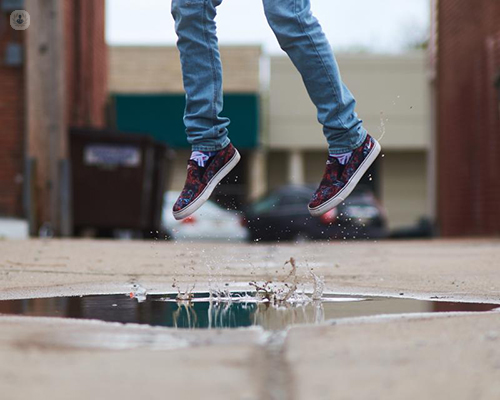Tips on foot care: ankle sprain and bunions
Written by:Common foot problems you may experience include injuries, such as an ankle sprain, which is usually the result of a fall or landing awkwardly on the foot after jumping, and bunions, which in some cases occur as the result of wearing improper footwear. We’ve asked leading orthopaedic surgeon Mr Paul Hamilton to give his top tips on what to do if you’ve sprained the ankle to ensure a speedy recovery and also the possible causes of bunions.

How long should an ankle sprain take to heal?
Ankle sprains are extremely common and usually recover very quickly without the need for treatment. Moderate or more severe ankle sprains may take up to six weeks to resolve, although the swelling may take longer to completely disappear.
What can you do to ensure the ankle heals as fast as possible?
Over the first few days, the mnemonic PRICE and HARM can be used as guidance. PRICE stands for protect: often with the support of a brace, rest: avoid strenuous activity and even use crutches, ice: for approximately fifteen minutes three times a day, compress: use an elastic bandage, and elevate: to reduce the swelling.
It is also important over the first few days to do no HARM. HARM stands for heat, no alcohol or running and massage.
It is important to seek immediate medical help if you are unable to weight-bare, have excessive swelling or a misshaped ankle, or there is any pain over the bones in the ankle. If the symptoms persist beyond six weeks I would also recommend an opinion and possible further investigation.
What causes bunions?
A true bunion is not a growth of bone but the movement of the first metatarsal bone towards the big toe and subsequently the big toe moves towards the smaller toes. Although in some cases it may run in families, if you develop a bunion, it does not mean your child will develop one as well.
Those more likely to develop bunions include individuals with ligament laxity and more flexible joints and women. Some people with systemic arthritis such as rheumatoid arthritis may also be more likely to develop bunions. Shoes may have an association but probably are not the cause, per se, of the condition. The shoes, however, may rub on the prominent bone and may cause the pain.
If you're worried about an ankle sprain then book an appointment with one of our specialists for an expert opinion.


